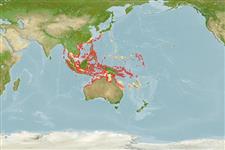>
Eupercaria/misc (Various families in series Eupercaria) >
Nemipteridae (Threadfin breams, Whiptail breams)
Etymology: Pentapodus: Greek, pente = five + Greek, pous = feet (Ref. 45335).
More on author: Cuvier.
Environment: milieu / climate zone / intervalo de profundidade / distribution range
Ecologia
marinhas associadas(os) a recifes; intervalo de profundidade 2 - 35 m (Ref. 90102). Tropical; 33°N - 24°S, 93°E - 175°E (Ref. 3810)
Western Pacific: southern South China Sea and the eastern Malay Peninsula to the Gilbert Islands, north to the Ryukyu Islands, south to Timor and New Caledonia (Ref. 37816). The name Pentapodus caninus has been misapplied to Pentapodus trivittatus.
Tamanho / Peso / Idade
Maturidade: Lm ? range ? - ? cm
Max length : 35.0 cm TL macho/indeterminado; (Ref. 9710); common length : 15.0 cm SL macho/indeterminado; (Ref. 3810)
Espinhos dorsais (total) : 10; Raios dorsais moles (total) : 9; Espinhos anais: 3; Raios anais moles: 7. Head scales reaching forward to or just in front of level of anterior nostrils. Scaled area between nostrils with a distinct naked medial wedge-shaped notch. Suborbital scaly posteriorly. Lower limb of preopercle with 2 or 3 scale rows. Pelvic fins moderately long, reaching to or almost to level of anus. Upper lobe of caudal fin slightly longer than lower. Axillary scale present. Color: Upper body pale blue, lower whitish.
Body shape (shape guide): fusiform / normal; Cross section: oval.
Usually found close to the bottom over coral reef areas. Feeds on small fishes and larger zooplankton, as well as on benthic organisms (Ref. 9785). Occurs solitary or in small groups.
Life cycle and mating behavior
Maturidade | Reprodução | Desova | Ovos | Fecundidade | Larvas
Russell, B.C., 1990. FAO Species Catalogue. Vol. 12. Nemipterid fishes of the world. (Threadfin breams, whiptail breams, monocle breams, dwarf monocle breams, and coral breams). Family Nemipteridae. An annotated and illustrated catalogue of nemipterid species known to date. FAO Fish. Synop. 125(12):149p. Rome: FAO. (Ref. 3810)
Categoria na Lista Vermelha da IUCN (Ref. 130435: Version 2025-1)
Ameaça para o homem
Harmless
Utilização humana
Pescarias: pescarias de subsistência
Ferramentas
Relatórios especiais
Descarregue XML
Fontes da internet
Estimates based on models
Preferred temperature (Ref.
123201): 26.4 - 29.3, mean 28.7 °C (based on 1974 cells).
Phylogenetic diversity index (Ref.
82804): PD
50 = 0.5001 [Uniqueness, from 0.5 = low to 2.0 = high].
Bayesian length-weight: a=0.01820 (0.01098 - 0.03017), b=2.94 (2.80 - 3.08), in cm total length, based on LWR estimates for this species & (Sub)family-body (Ref.
93245).
Nível Trófico (Ref.
69278): 3.6 ±0.49 se; based on food items.
Resiliência (Ref.
120179): Médio, tempo mínimo de duplicação da população 1,4 - 4,4 anos (Preliminary K or Fecundity.).
Fishing Vulnerability (Ref.
59153): Low vulnerability (25 of 100).
🛈
Nutrients (Ref.
124155): Calcium = 51 [32, 107] mg/100g; Iron = 0.707 [0.350, 1.491] mg/100g; Protein = 18.9 [17.0, 20.6] %; Omega3 = 0.138 [0.081, 0.239] g/100g; Selenium = 28.3 [16.3, 52.6] μg/100g; VitaminA = 109 [30, 319] μg/100g; Zinc = 1.12 [0.76, 1.60] mg/100g (wet weight);
